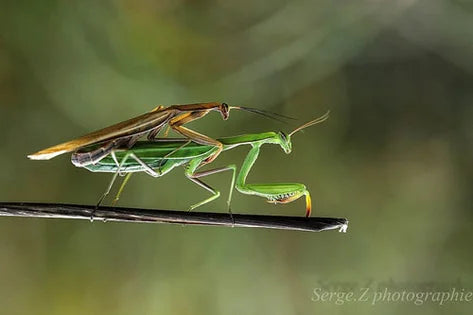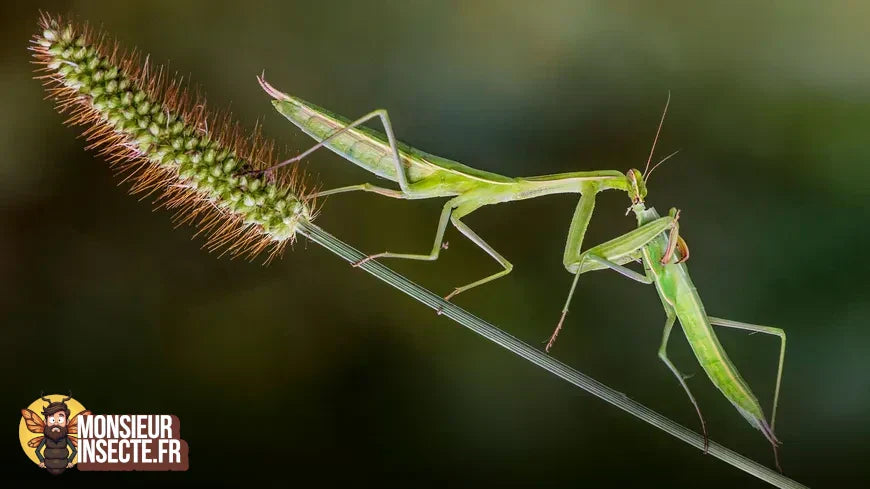How does the praying mantis reproduce?
Introduction
The praying mantis (order Mantodea) is a fascinating insect, known to the general public for its cannibalistic behavior and predatory appearance. Belonging to the arthropods ( roughly speaking, insects with external skeletons, their chitin "shells" IS their skeleton ), it is distinguished by its powerful forelegs adapted to capturing prey and its elongated thorax. Among the many species recorded in the insect world, some are particularly studied in entomology for their methods of reproduction, their life cycle and their role in biodiversity. Let's discover together the different stages of the reproductive cycle of the praying mantis, from the fatal courtship display to the hatching of the larvae.
The reproductive phase: from meeting to mating
Partner search
During the warm season, praying mantises enter their breeding season. In breeding, this period is simulated by temperatures ranging from 22°C to 30°C for some species. It is indeed very difficult to achieve good reproduction below 20°C.
Females, often larger and more robust than males, emit pheromones to attract a mate. Males use their long antennae and compound eyes to locate these chemical signals. Antenna size, which is also a factor in sexing, although the number of abdominal segments is preferred.

Here you can clearly see that the male, although significantly smaller than the female, has longer antennae. These are used to detect the female's pheromones. (Photo credit: Serge.Z).
Courtship and Mating
Before mating, the male adopts a cautious approach. He spreads his forewings and makes jerky movements to indicate his intentions. When the female accepts the male, he climbs onto her back and sometimes hammers the female's back with his captors to signal to her that he is not prey. Mating can last several hours and involves the transfer of sperm via a structure called a spermatophore. A single mating is enough for the praying mantis to lay between 1 and 7 oothecae (usually 4/5) during the rest of its life. However, some breeders like to repeat the mating as a safety precaution, although the practice is not really scientifically validated.
Sexual cannibalism: a fascinating phenomenon
One of the most well-known behaviors of the praying mantis is sexual cannibalism. In many cases, the female devours the male during or after mating, and unfortunately for breeders, often BEFORE. This partly justifies the price of praying mantises compared to stick insects, for example. This behavior, although dramatic, has evolutionary advantages: it allows the female to acquire essential nutrients for egg production and maximizes the male's reproductive success by promoting embryonic development.
Here you can observe the incredible ability of the male mantid to position himself and reproduce without his head.
Egg laying and embryonic development
The formation of the ootheca
After mating, the female lays her eggs in a protective structure called an ootheca. This capsule, usually beige or brown, is made from a substance secreted by the abdomen that hardens upon contact with air. Each ootheca can contain 50 to 200 eggs depending on the species. Note that this number varies greatly depending on the species and that not all eggs are viable. The Sinomantis denticulata (which we are the only ones to offer in the West) only offers about twenty viable eggs per ootheca.

Here is a Prohierodula Picta and its GIGANTIC ootheca from the breeding of your humble servant.
Incubation and hatching
The eggs undergo an incubation phase lasting several weeks to several months, depending on environmental conditions. Temperature, humidity, and the presence of predators influence embryo survival. When conditions become favorable, the larvae emerge as nymphs, already resembling adults but smaller.

Here is a hatch of Astyliasula basinigra (boxing mantis available here)
Some species can be VERY prolific. Hence the variable cost depending on the praying mantises.
Post-embryonic development
The different larval stages
Young mantises go through several molts before reaching the adult stage (imago). Each molt allows for progressive growth and development of appendages, including the forelegs and hindwings. Nymphs already have a morphology close to adults but without fully developed wings. Here, the term nymph refers to any non-adult mantis. Note that as with most "insects," the adult stage represents the end of the arthropod's life and not the beginning of it as it does for humans.

EXCEPTIONAL illustration of the different life stages of a praying mantis (probably sphodromantis). Oh, if only I had this talent for drawing, I would go live in Thailand alone on a mountain to draw praying mantises!
Sexual maturity
Once the imago stage is reached, the praying mantis is capable of reproducing. The lifespan of a mantis varies depending on the species and living conditions (captivity, climate, presence of predators such as spiders, birds, or amphibians). On average, it lives from six months to a year. Note that in breeding, good breeders will discard the weakest specimens, thus imitating natural selection, to keep only the strongest and most interesting individuals to reproduce.
Conclusion
Praying mantis reproduction is a fascinating process that perfectly illustrates the adaptive strategies of the insect world. From mate selection to larval development, each step is crucial to the survival of the species. Although it is best known for eating its male, praying mantis reproduction is a delicate and technical process that, if successful, offers immense satisfaction to the breeder.
Ready to take the plunge? You know what to do 😁. In any case, we're always available on social media to guide you.



Leave a comment
This site is protected by hCaptcha and the hCaptcha Privacy Policy and Terms of Service apply.